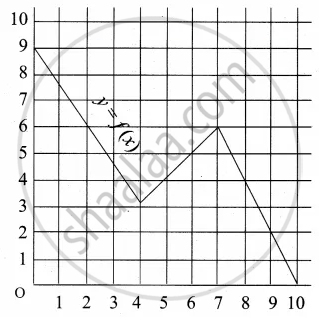Advertisements
Advertisements
प्रश्न
The equation logx2 16 + log2x 64 = 3 has,
पर्याय
one irrational solution
no prime solution
two real solutions
one integral solution
उत्तर
two real solutions
Explanation;
logx2 16 + log2x 64 = 3
∴ `(log_(2)16)/(log_(2)x^2) + (log_(2)64)/(log_2(2x))` = 3
∴ `(log_(2)2^4)/(2log_(2)x) + (log_(2)2^6)/(log_(2)2 + log_(2)x` = 3
∴ `(4log_(2)2)/(2log_(2)x) + (6log_(2)2)/(1 + log_(2)x)` = 3
∴ `2/"m"+6/(1+"m")` = 3 .....[m = log2 x]
∴ 2(1 + m) + 6m = 3m(1 + m)
∴ 2 + 2m + 6m = 3m + 3m2
∴ 3m2 – 5m – 2 = 0
∴ 3m2 – 6m + 1m – 2 = 0
∴ 3m(m – 2) + 1(m – 2) = 0
∴ (m – 2)(3m + 1) = 0
∴ m – 2 = 0 or 3m + 1 = 0
∴ m = 2 or m = `-1/3`
∴ log2 x = 2 or log2 x = `-1/3`
∴ x = 4 or x = `2^(-1/3)`
APPEARS IN
संबंधित प्रश्न
If f(x) = x2, find \[\frac{f\left( 1 . 1 \right) - f\left( 1 \right)}{\left( 1 . 1 \right) - 1}\]
If \[y = f\left( x \right) = \frac{ax - b}{bx - a}\] , show that x = f(y).
If \[f\left( x \right) = \frac{2x}{1 + x^2}\] , show that f(tan θ) = sin 2θ.
If for non-zero x, af(x) + bf \[\left( \frac{1}{x} \right) = \frac{1}{x} - 5\] , where a ≠ b, then find f(x).
Let f and g be two real functions defined by \[f\left( x \right) = \sqrt{x + 1}\] and \[g\left( x \right) = \sqrt{9 - x^2}\] . Then, describe function:
(i) f + g
If f(x) = loge (1 − x) and g(x) = [x], then determine function:
(ii) fg
Let \[f\left( x \right) = \frac{\alpha x}{x + 1}, x \neq - 1\] . Then write the value of α satisfying f(f(x)) = x for all x ≠ −1.
Write the domain and range of the function \[f\left( x \right) = \frac{x - 2}{2 - x}\] .
Write the domain and range of function f(x) given by \[f\left( x \right) = \sqrt{\left[ x \right] - x}\] .
If f(m) = m2 − 3m + 1, find f(0)
If ƒ(m) = m2 − 3m + 1, find f(x + 1)
If f(x) = `{(x^2 + 3"," x ≤ 2),(5x + 7"," x > 2):},` then find f(0)
Check if the following relation is a function.

Check the injectivity and surjectivity of the following function.
f : R → R given by f(x) = x3
Express the following exponential equation in logarithmic form
10−2 = 0.01
Express the following exponential equation in logarithmic form
e2 = 7.3890
Find the domain of f(x) = ln (x − 5)
Write the following expression as sum or difference of logarithm
`log ("pq"/"rs")`
Write the following expression as sum or difference of logarithm
In `[(root(3)(x - 2)(2x + 1)^4)/((x + 4)sqrt(2x + 4))]^2`
If `log((x + y)/3) = 1/2 log x + 1/2 logy`, show that `x/y + y/x` = 7
If f(x) = 3x + 5, g(x) = 6x − 1, then find (fg) (3)
Select the correct answer from given alternatives.
If f(x) =`1/(1 - x)`, then f{f[f(x)]} is
Answer the following:
Identify the following relation is the function? If it is a function determine its domain and range.
{(2, 1), (4, 2), (6, 3), (8, 4), (10, 5), (12, 6), (14, 7)}
Answer the following:
Identify the following relation is the function? If it is a function determine its domain and range
{(12, 1), (3, 1), (5, 2)}
Answer the following:
Solve for x, logx (8x – 3) – logx 4 = 2
Find the domain of the following function.
f(x) = `sqrtlog(x^2 - 6x + 6)`
Answer the following:
Find the range of the following function.
f(x) = |x – 5|
A graph representing the function f(x) is given in it is clear that f(9) = 2

What is the image of 6 under f?
A function f is defined by f(x) = 2x – 3 find `("f"(0) + "f"(1))/2`
The data in the adjacent table depicts the length of a person's forehand and their corresponding height. Based on this data, a student finds a relationship between the height (y) and the forehand length (x) as y = ax + b, where a, b are constant.
| Length ‘x’ of forehand (in cm) |
Height 'y' (in inches) |
| 35 | 56 |
| 45 | 65 |
| 50 | 69.5 |
| 55 | 74 |
Check if this relation is a function
The domain of the real valued function f(x) = `sqrt((x - 2)/(3 - x))` is ______.
If a function f(x) is given as f(x) = x2 – 6x + 4 for all x ∈ R, then f(–3) = ______.
Find the range of the following functions given by `|x - 4|/(x - 4)`
Find the domain of the following function given by:
f(x) = `(3x)/(2x - 8)`
Find the range of the following functions given by f(x) = |x − 3|
Find the range of the following functions given by f(x) = 1 + 3 cos2x
(Hint: –1 ≤ cos 2x ≤ 1 ⇒ –3 ≤ 3 cos 2x ≤ 3 ⇒ –2 ≤ 1 + 3cos 2x ≤ 4)
The domain and range of real function f defined by f(x) = `sqrt(x - 1)` is given by ______.
The range of the function y = `1/(2 - sin3x)` is ______.
The range of the function f(x) = `""^(7 - x)P_(x - 3)` is ______.
